As someone who has lived in Kyoto for several months now, I thought it might be helpful to write a basic guide for the people who are going to the PT. The guide covers transportation, some basic advice, and recommendations (for food, drinking, recreation, sightseeing), and contains some basic Japanese phrases and words at the end.
GETTING AROUND
To Kyoto from KIX: There is a train station
a couple minutes’ walk from International Arrivals. Take the Haruka
train to Kyoto Station. If you have purchased a JR pass, you can use
it to cover this fare; otherwise it will cost 2980 for a non-reserved
seat. The ride takes about 75 minutes. Trains leave on every half-hour,
with the last one departing at 8:30.
Within Kyoto:
There are several train and subway lines
in Kyoto, as well as a bus system. I’m only going to list the ones that
I think are important,
1) The KEIHAN line goes from Demachiyanagi
station (Imperial Palace, Ginkakuji temple) all the way south to Osaka.
The important stops are Sanjo (shopping, nightlife), Gion-Shijo
(shopping, nightlife, Yasaka shrine, Heian shrine), Kiyomizu-Gojo
(Kiyomizu temple), Fushimi-Inari (Fushimi-Inari Shrine), Tambabashi
(transfer to the Kintetsu line), and Yodoyabashi (a large station
in Osaka, if you plan to go there).
2) The KINTETSU line goes from Kyoto
station down to Nara. The important stops are Kyoto (main transportation
hub, shopping), Takeda (the PT venue, one of my favorite izakayas),
Tambabashi (transfer to the Keihan line), and Yamato-Saidaiji
(terminus in Nara if you plan to go there, Saidaiji temple).
3) The HANKYU KYOTO line goes from the
Shijo/Kawaramachi intersection to Osaka. I don’t use it much, but it
does take you to Umeda (a cool part of Osaka). The important stops are
Kawaramachi (a couple minutes down Shijo street from Keihan Gion-Shijo
station), Karasuma (transfer to the Karasuma Subway line at Karasuma
Shijo station), and Umeda (Osaka: shopping, transfer to other
Osaka train lines).
4) The KARASUMA SUBWAY line goes from
northeast Kyoto to Takeda, the PT venue. The important stops are
Imadegawa (Imperial Palace), Shijo
(transfer to the Hankyu line at Hankyu Karasuma station), Kyoto,
and Takeda.
5) I rarely use the JAPAN RAIL (JR) lines
because the previous ones take me everywhere I usually go, but they’re
important because JR runs the Shinkansen (bullet train), which is the
best way to get to Tokyo, Hiroshima, or any other relatively far destinations
you may visit. JR operates out of Kyoto Station.
6) I don’t have much experience with
the KYOTO CITY BUSES, but there are many routes, and the system covers
most of the important sightseeing, shopping and nightlife sites. The
buses all have their destination and notable stops listed below the
route number at each bus stop, as well as a map showing the routes on
a simple layout of Kyoto’s streets. They’re somewhat slow when compared
to the trains, but cover a wider area. A single ride costs 220, while
a day pass is 500.
Important: if you go out at night,
make sure you don’t miss the last train!
Japanese trains end relatively early, and the last one usually departs
around 12 AM, depending on the station and destination. If you don’t
want to pay for a cab (~1500 – 2000, depending on the trip), head back
towards your train station by 11:45. Leave even earlier if your trip
requires a transfer somewhere.
PROTIPS
Most people in stores and restaurants
speak limited english, so if you find yourself lost or have questions
about a purchase/meal, you should be alright. Generally, the more traditional
or hole-in-the-wall a place looks, the less chance there is of anyone
speaking english.
Police boxes (recognizable from the words
KOBAN and a picture of a policeman riding a horse) are very useful when
you’re lost. Just tell the policeman where you want to go and he’ll
show you on a map.
Most convenience stores have incredibly
clean restrooms, so if you need a bathroom while you’re out, just go
to the nearest 7-11/Lawson/Circle-K/Family Mart.
If you think you’re near the place you
want to go to but can’t find it, just ask any random by saying the name
of the place you want to go. If you’re close to it, they’ll be able
to point you in the right direction, and some people are nice enough
to walk you there.
DOWNTOWN
Virtually all of the following recommendations
for restaurants and bars are in the downtown area of Shijo and Sanjo.
The best way to get there is KEIHAN, using Gion-Shijo
and Sanjo stations.
If your hotel is close to the KARASUMA
SUBWAY line, take the subway to Shijo station and transfer to
the HANKYU KYOTO line. Take Hankyu to Kawaramachi station, and
you’ll be in Shijo.
If your hotel is close to the KINTETSU
line, take the train to Tambabashi and transfer there to KEIHAN,
then take the Keihan train to Gion-Shijo
or Sanjo station.
If your hotel is close to the HANKYU
KYOTO line, just take the train to Kawaramachi station, and you’ll
be in Shijo.
RECOMMENDATIONS
I’m a college student on a budget, so
here are some pretty good places that may not blow your mind but definitely
won’t bust your wallet. This is by no means an exhaustive list of all
that Kyoto has to offer; these are just the places I like and frequently
visit.
FOOD
Kyoto is full of all sorts of restaurants,
but be warned that most "foreign" food is a Japanized version.
Some places specialize in tabehoudai (all you can eat buffet);
if no sign mentions it, don’t be afraid to ask.
Unlike American ones, Japanese convenience
stores are full of surprisingly high-quality food for cheap. Beyond
regular snack foods, you can get fried food, meat buns, sushi, rice
balls, sandwiches, bento (Japanese box-lunches) and even pasta
that the cashier will microwave for you. Convenience stores are all
open 24/7.
Fast food: Many fast food joints in Japan
are open 24/7, and the food is generally much higher-quality than food
of a comparable price in the US. Aside from McDonald’s, Japan has:
Mos
Burger – A tastier and more expensive burger chain than McDonald’s,
but the portions are somewhat small. A set is ~600-800, depending on
the burger.
Sukiya
– Japanese rice bowls, curries, and traditional side dishes in the 300-600
range.
Matsuya
– Like Sukiya, but with more emphasis on the rice bowls and less on
the curry. Rice bowls are from ~350 to 500.
CoCo
Curry – Japanese curry with rice. Wide variety, tasty, runs from ~600-1000.
Shakey’s
Pizza – For those brave enough to try Japanese pizza, Shakey’s is the
place to go. Shakey’s offers "Lunch Viking" and "Dinner
Viking," which is an odd way of saying "all you can eat buffet,"
for stupidly cheap – lunch for ~650, dinner for ~850. In addition to
pizza, you can also get curry rice, pasta and salad. Try the banana
chocolate dessert pizza; it’s actually pretty good. Shakey’s pizza is
on Teramachi, between Shijo and Sanjo streets (for how to get
to Teramachi, look at the SHOPPING section).
Sushi: It’s hard to go wrong with the
sushi here, but unless you get it from a convenience store it will be
relatively expensive (compared to other options). The two sushi places
I usually frequent represent opposite sides of the quality/quantity
argument, and are both on Sanjo street.
Ganko-zushi
– From Keihan Sanjo station, cross the bridge west towards Starbucks,
on the right-hand side of the street. Continue past Starbucks and you’ll
soon be in front of Ganko-zushi, recognizable by its logo of a serious-looking
sushi chef’s head. The food is very good, and the sashimi’s quality
is excellent, but expect to pay a minimum of 2000 yen if you don’t want
to leave hungry. They have an English menu.
Kappa
Sushi – Follow the same directions as Ganko-zushi, but continue along
down Sanjo street until the street ends. As soon as you cross Kawaramachi
street, Kappa sushi will be on the left-hand side, recognizable by its
logo of a cute vaguely-turtleish green cartoon character dressed up
like a sushi chef. Kappa Sushi is a kaitenzushi (conveyor-belt
sushi) establishment. After you’re seated, you can freely grab sushi
as it comes by on small trays. You can also place a special order using
the touch screen at each table, and the food will come on a minature
bullet train. Just remember to press the red button to send the train
back! Most plates have 2 pieces of sushi and cost 105 yen.
Okonomiyaki: Also called "Japanese
pizza," okonomiyaki is a pancake-like batter filled with various
vegetables and meat/seafood and cooked on a hot plate. Okonomiyaki restaurants
may not have a sign in English, but the Japanese looks like this: お好み焼き. You
can’t go wrong with buta (pork) or niku (beef), and for
those who like seafood there’s ika (squid) and ebi (shrimp).
I
forget the name – From Keihan Sanjo station, cross the bridge
west towards Starbucks, on the left-hand side of the street. Continue
until you reach an intersection with a light (Sanjo and Kiyamachi),
and turn left onto Kiyamachi street. Walk down Kiyamachi on the left-hand
side of the street until you see a 7-11. Next to the entrance of the
7-11 there is an elevator, and next to the elevator are a bunch of signs,
including one for okonomiyaki. Go to the floor that sign advertises.
The okonomiyaki will be about 800-1000 on average.
Ramen: Ramen shops are as delicious as
they are ubiquitous. Recognize them by the Japanese ラーメン or らーめん. The basic shoyu ramen (soy-sauce ramen)
will cost between 500-700, and is very filling. Gyoza (chinese
pot-stickers) make a good side dish, and should be between 200-300 for
5 or 6.
DRINKING
Japan is a great place to get drunk.
There are no penalties for public drinking or public drunkenness, so
as long as you aren’t being an obnoxious dickhead you’ll be fine. There
are a couple main types of drinking establishments in Japan:
The izakaya – the Japanese characters
for izakaya literally translate to "eat drink store,"
and that’s what you’ll do. Izakaya are the traditional bars of
Japan, with a food menu full of authentic Japanese fried and grilled
dishes and a hybrid drink selection consisting of sake (rice
wine) and shochu (potato liquor, somewhat similar to vodka) alongside
the usual beer and mixed drinks.
The bar – your usual bar; cocktails and
mixed nuts.
Undoubtedly, the best thing about drinking
in Japan is nomihoudai (all you can drink buffet). Instead of
paying for drinks, you pay a fixed price for 1.5 to 3 hours of as many
drinks as you can have. Some places charge extra to include beer as
part of the buffet. Not all bars offer nomihoudai, so be sure
to ask. Also, beware that some places underhandedly limit the number
of drinks you have, through slow service or watery drinks.
A Bar: One of my favorite bars in Kyoto,
A Bar has reasonably priced Yebisu beers, good food selection, and a
great atmosphere. Instead of the usual setup, there are several smaller
booths with a huge table in the center. Sharpie grafitti left by prior
celebrants covers the walls, and on weekends it’s hard not to make new
friends, whether Japanese or fellow foreigners. A large beer will run
you ~600, and mixed drinks are 500. From Keihan Shijo
station, cross the bridge west toward McDonalds. Make a right onto Kiyamachi
street, and cross over to the left (far) side of the river on Kiyamachi.
Pass club world, and go straight into the alley. Continue straight into
the next alley until you see the sign for A Bar on your left, on the
second floor.
Cafe La Siesta: My other favorite bar
in Kyoto, Cafe La Siesta is a gamer’s paradise. The music is always
8-bit, a Super Street Fighter 2 machine sits next to the bar, and there’s
a giant Game Boy with a TV inside hooked up to a NES with a sizable
collection of the best games. The Thai curry (700) is great, and while
original drinks named 1-Up, Bonus Stage and Continue start at 600, you
can get 1.5 hours of nomihoudai for 2100. The service is usually
fast, the owners are good people, and you can request the drinks strong.
The directions are the same as A Bar, but Cafe La Siesta is on the first
floor instead of the second.
Jidaiya: This izakaya chain is
probably the best drinking deal in town. Located right next to Takeda
station, Jidaiya has great, cheap traditional Japanese bar snacks, but
the real draw is 1.5 hours of nomihoudai for 900 yen. Try the
yakitori (grilled chicken sticks); they’re delicious, and a steal
at only 80 yen a stick. For nomihoudai, you have to reserve in
advance; it fills up quickly on weekends, so the sooner you figure out
how many people and when, the better. Also, they speak very limited
English, so you might want to have a Japanese judge reserve for you.
The number is 075 622 0765. I don’t remember exactly what exit it’s
next to, but if just say "Jidaiya? Izakaya?" to an employee
at Takeda station, they’ll be able to direct you.
Seagulls: While they also offer food,
the main draw for Seagulls is getting as smashed as possible. 3 hours
of nomihoudai costs 2000 (2300 with beer included), but you can
order your drinks strong. Be sure to order a drink whenever you receive
one, as the service can be a bit slow unless you’re insistent about
getting your way. From Keihan Sanjo station, cross the bridge
west towards Lawson. Make a left onto Kiyamachi street, and continue
straight until you see an izakaya called "Watami" on
a corner on the right-hand side of the street. Turn right and walk straight
past the Watami and the bowling alley. Seagulls will be on the right
side of the street on the 3rd floor, across from the Hub.
SHOPPING
Things are more expensive here than in
America, but there are many stores where you can shop duty-free. Otherwise,
check out the outdoor shopping arcades of Teramachi and Shinkyogoku
in Sanjo/Shijo.
Kyoto Station: Kyoto station is a huge
complex of restaurants and stores, with an underground mall. If you
want to buy things duty-free, go to Bic Camera for a giant selection
of electronics.
Teramachi/Shinkyogoku: The shopping arcades
of Teramachi and Shinkyogoku, bordered by Sanjo street at the north
end and Shijo street in the south, offer the best shopping in Kyoto.
Lined with stores, restaurants and even a couple game centers, there’s
little you won’t be able to find. To get to Teramamachi and Shinkyogoku:
From
KEIHAN Sanjo station, cross the bridge west towards Lawson. Continue
going straight along Sanjo street until the street becomes a dead end.
Cross the street, and walk into the covered walkway. The arcades will
trail off to the left; the nearer one is Shinkyogoku, and the further
one is Teramachi.
From
KEIHAN Gion-Shijo station, cross the bridge west towards McDonalds.
Continue straight along Shijo street until you see a sign on your right
for Shinkyogoku; if you go a bit further, you will see a sign on your
right for Teramachi.
From
HANKYU Kawaramachi station: Kawaramachi station has many exits.
Take any of the exits that lets you out on Shijo Street, and from there
walk west down Shijo street until you see the signs for Shinkyogoku
and Teramachi. If you accidentally find yourself exiting into the Takashimaya
department store, you can ask any of the workers to direct you to Shijo
street.
Taniyama Electronics Store: Like Bic
Camera but smaller, Taniyama is a several-story shop where you can buy
electronics, and the entire 5th floor is duty free. To get
there, follow the same directions as for getting to Teramachi from
Gion-Shijo or Kawaramachi stations, but when you get to the
sign that says “Teramachi,” instead of going into the arcade, go
the opposite direction down the street. Taniyama will be on your right
after a short walk.
RECREATION
Karaoke: Japanese karaoke centers are
multi-storied affairs with private rooms for each party, room service
for food and drinks, and large song selections. If you’ve never tried
it, you really should—anyone who has played Rock Band knows the awesome
fun of singing poorly to your favorite music. Songs you must try: “Welcome
to the Jungle,” “Say It Ain’t So,” and “Snake Eater Song”
from MGS3. They’re virtually everywhere, but if you don’t
see “Karaoke” in English, you can recognize a karaoke center by
the Japanese カラオケ. You pay by the hour, and the cheapest times
are from around 12 PM to around 5 PM.
Game Centers (Arcades): If you have an
absurd craving to get your ass kicked at Street Fighter IV, there are
two good arcades in the Shijo/Sanjo downtown area.
Round
1 is a large complex with ticket games, air hockey and crane games aside
your usual fighters, racers and gun games. From KEIHAN Sanjo
station, cross the bridge west towards Lawson. Continue straight down
Sanjo street until the road ends at Kawaramachi street. Cross to the
dead-end side, and turn left. Walk south down Kawaramachi street towards
Shijo street. After a short walk, Round 1 will be on your right. The
real games are all from the 3rd floor up. Most games are
100 yen per play, but SFIV gives you two plays.
For
the hardcore, Amusement A-Cho on Teramachi street is a no-nonsense
arcade stacked with almost every major fighter from the last two decades.
The competition is much better than at Round 1, so don’t be surprised
if you lose. A lot. To get there, follow the directions for Teramachi
street from Gion-Shijo station. Enter Teramachi, and after a
short walk you will see a sign for Amusement A-Cho high up on your right.
Go up the escalator, and you’ll be on the gaming floor. Most games
are 50 yen per play.
Clubs: The downtown area has more than
a few clubs, but I’ve only been to a couple of them. Japanese dancing
etiquette is different, as people often dance by themselves, and depending
on the place may not be as receptive to your advances as they would
in America. Be courteous, get drunk and rock out.
Sam & Dave: This gaijin-owned
chain is very popular in Kansai (western Japan), and its Kyoto
location is on Kiyamachi street between Sanjo and Shijo, close
to 7-11 and the okonomiyaki restaurant. Entry for men is 2000 and comes
with 2 drink tickets. The first floor has a pool table, and the second
floor is the main dance area. Sam & Dave is known for its foreigner
population, so you’ll see a lot of other gaijin as well as
questionable Japanese girls looking to hook up with said gaijin.
Club World: The biggest club in Kyoto,
Club World is classier, has better music, and is frequented by fewer
gaijin than Sam & Dave. However, the entry is a hefty 3000 yen,
and only comes with 1 drink ticket. From Gion-Shijo
station, cross the bridge towards the McDonalds. Turn right at the first
intersection (Kiyamachi street), and walk down Kiyamachi on the left-hand
(far) side of the river. You will soon be at Club World.
SIGHTSEEING
While the Pro Tour will take up most
of your time, this may be the only chance you have to come to Japan,
and it’d be a shame not to see one of the many beautiful, easily accessible
cultural spots in Kyoto.
Kinkakuji: Also known as the Temple of
the Golden Pavilion, this gilded Buddhist temple sits atop a placid
pond. It’s a bit out of the way, but well worth it. Admission is ~500.
To get there, take the 101 or 205 bus from Kyoto Station (or
any stop along the way). Alternately, a faster method is to take the
KARASUMA SUBWAY line to Kitaoji station, and take a bus or taxi
from there to Kinkakuji.
Ginkakuji: Although the name literally
translates as “Temple of the Silver Pavilion,” Ginkakuji is actually
a wooden structure. While it’s currently under construction, the real
draw is the traditional walking garden path that winds through the carefully
sculpted grounds. Admission is ~500. To get there, take the 5, 17 or
100 bus from Kyoto Station. If you’re already near a KEIHAN
station, it’s a better idea to take the train to Demachiyanagi
station, and take one of the same buses from there.
Kiyomizu-dera: Sitting on a hill, the
beautiful Kiyomizu temple offers a great view of Kyoto. One of the older
temples in Japan, Kiyomizu-dera is known for its sacred water that is
purported to bring longevity, wisdom, and health. Lesser-known but close
by lies a massive Japanese graveyard with stones dating back to the
mid-1800s. From KEIHAN Kiyomizu-Gojo station, walk west towards
the row of convenience stores. Continue straight along Gojo street until
you come upon a diagonal cross-street and a steep hill straight ahead.
Go up the hill; Kiyomizu-dera is a the top.
Fushimi-Inari Taisha: My favorite place
in Kyoto, Fushimi-Inari shrine offers a pleasant hike and some valuable
silence, both of which are relatively hard to come by in Japan. The
main shrine for the god of fortune, Fushimi-Inari is a hill criss-crossed
with dozens of paths that are lined with 10,000 red gates in total.
Along the hike, you’ll encounter many side paths leading to shrines
of various sizes, and countless statues of foxes in red bibs. The shrines
at the top of the hill are full of friendly cats, and I highly recommend
making the whole circuit. The best time to go is at sundown; hundreds
of lamps illuminate the mountain, and you won’t run into to too many
other people. From KEIHAN Fushimi-Inari station, head across
the train tracks going uphill. Just follow the path straight, and go
in the same direction as the other tourists. Make sure you don’t get
lost on the mountain; the paths can be confusing. Trivia: While hiking
at Fushimi-Inari, the idea of foxes in red bibs flying through gates
inspired Shigeru Miyamoto to create Starfox.
FOR THOSE OF YOU WHO WANT TO TRY: BASIC
JAPANESE
Japanese is a fairly difficult language,
and the grammar is very different from that of English. Here’s a basic
pronunciation guide, a list of important questions and phrases, and
a list of words you can substitute into said sentences.
Pronunciation: Japanese pronunciation
is much simpler than you might imagine. There are five vowels: A, I,
U, E, and O.
A is pronounced ah, as in law or saab.
I is pronounced ee, as in feed or knee.
U is pronounced ooh, as in you or do.
E is pronounced ay, as in play or way.
O is pronounced oh, as in low or dough.
All the consonants are similar to those
in English, with the exception of:
“R” sounds like a mix of L and R;
try saying “R” while touching the tip of your tongue to the roof
of your mouth.
“F” sounds like a mix of F and H;
try saying “F” without touching your upper teeth to your lower lip.
Additionally, Japanese uses “Tsu,”
which is pronounced how it is written.
“J” is ALWAYS pronounced like J as
in “jam” or “jump”.
Useful sentence Patterns:
WHERE: _______ wa doko desu ka? (where
is ___?)
HOW MUCH: _______ wa ikura desu ka?
(how much is ___?)
DIRECTIONS: _______ ni dou ikimasu ka?
(how do I get to ___?)
DO YOU HAVE: _______ wa arimasu ka?
(do you have/is there ___?)
WHEN: ______ wa itsu desu ka? (when
is ___?)
Useful phrases:
Konnichiwa. (Hello)
Jaa ne! (Goodbye!)
Arigatou. (Thank you.)
Onegaishimasu. (Please.)
Sumimasen. (Excuse me.)
Gomen nasai. (Sorry.)
Eigo o hanasemasu ka? (Do you speak
English?)
Nihongo o hanasemasen. (I don’t
speak Japanese.)
Useful words:
Places:
Train station: Eki
Toilet: Toire
Convenience Store: Konbini
Bar: Izakaya, Baa
Restaurant: Resutoran
Police Box: Koban
Bakery: Panya
Sushi restaurant: Sushiya
Bookstore: Honya
Arcade: Geemu Senta
Japan: Nihon
Japanese (language): Nihongo
Japanese (person): Nihonjin
Things:
Train: Densha
Taxi: Takushii
Food: Tabemono
Drinks: Nomimono
Alcohol: Sake
Beer: Biiru
Lunch: Hirugohan
Dinner: Bangohan
END
I hope some of this has been useful.
This basic guide is by no means exhaustive, and I can already think
of a few cool things I haven’t even had the time to write yet, but
it should help you get around reasonably well. Good luck in the PT!
P.S.: If I know you from GG or MT and
you’d like my number for emergency contact or general information
purposes, send me a request via GMail at srosenblum.
(Discuss this item in the forum!)



























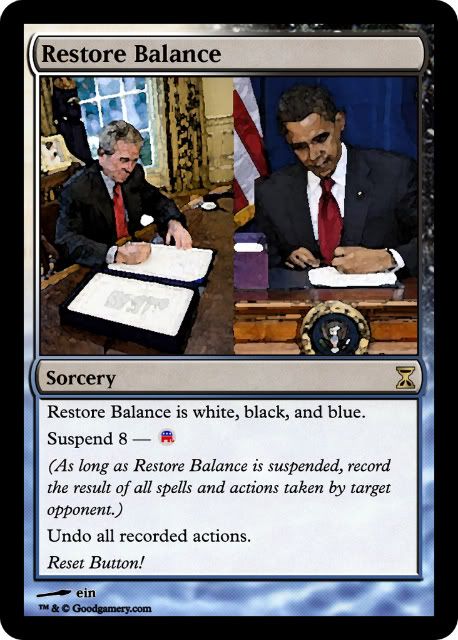


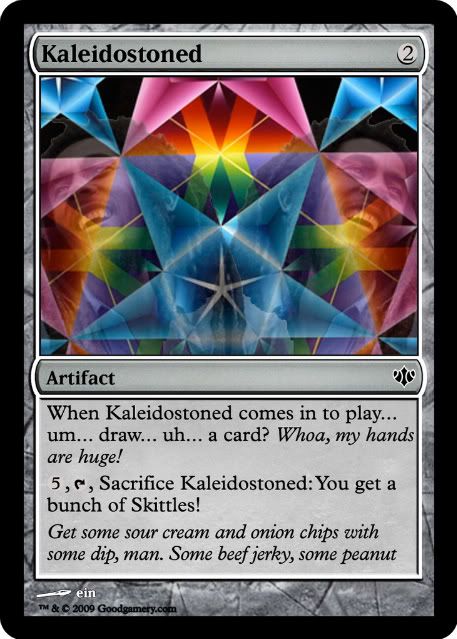



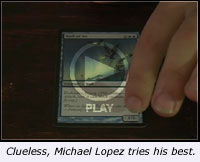
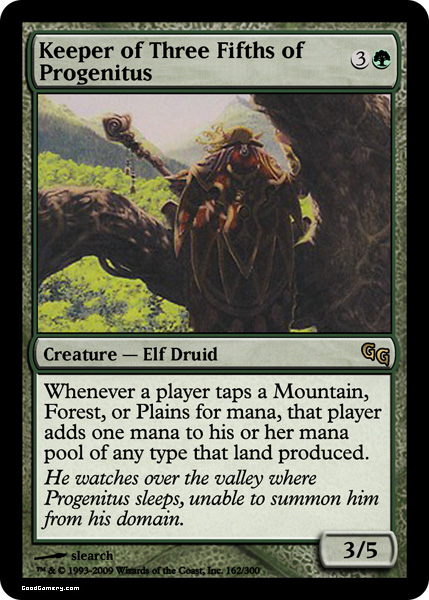

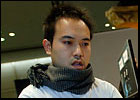
 Feb 26, 2009 – [card]Gwafa Hazid, profiteer[/card] and legendary real estate success, was found guilty by the Supreme Court today of bribery and high treason. Over the past three decades, Hazid navigated the real estate world like none other and brokered trade deals that none thought possible. After a rousing success in the financial field, he later moved on to the political arena as an intermediary negotiator.
Feb 26, 2009 – [card]Gwafa Hazid, profiteer[/card] and legendary real estate success, was found guilty by the Supreme Court today of bribery and high treason. Over the past three decades, Hazid navigated the real estate world like none other and brokered trade deals that none thought possible. After a rousing success in the financial field, he later moved on to the political arena as an intermediary negotiator.